Vol 2 No. 22 TROPIC LIGHTNING NEWS June 5, 1967
Index
25th Starts 3 New Operations
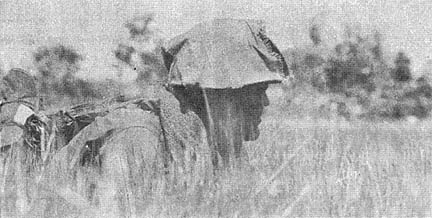
Kolekole, Diamondhead And Barking Sands
"Kolekole," "Barking Sands" and "Diamondhead".
These are the three latest operations underway involving units of the 25th
Inf. Div. Following the Hawaiian heritage, the "Tropic Lightning" Div. named
the three operations after a pass, a beach area and of course the most prominent
point, all in the Islands.
Kolekole began May 15. Elements of the 2nd Bde. are operating in an area
centered around Duc Lap southwest of the Cu Chi base camp.
The 1st Bde. is operating under Barking Sands which also started on the
15th. The area of operation includes Trung Lap and the surrounding vicinity.
The 3rd Sqdn., 4th Cav., is also in on the action.
May 19 was the start of Operation Diamondhead being conducted by the 3rd Bde.,
4th Inf. Div., under operational control of the 25th. This action is located
between Dau Tieng and Tay Ninh.
MAJ Berlin Springstead, operation and plans officer for the 25th Inf. Div.,
said the three operations are being conducted to disrupt the infrastructure of
the enemy. Other objectives are to destroy his lines of communication and
supply, and to execute search and destroy action against VC main force units and
the installations used by the enemy.
CA Used With 'Seal'
A dawn search and seal of a hamlet east of the combat base of the 1st Bn. (Mech),
5th Inf., recently, produced no Viet Cong but did prove the worth of a different
idea in village search.
The 25th Inf. Div. soldiers were taking part in the 2nd Bde. Operation "Kolekole,"
a current combat operation being conducted southwest of the "Tropic Lightning"
Div.'s base camp.
The soldiers surrounded the hamlet just as the first hints of dawn showed
themselves on the surrounding rice paddies. The seal was complete as the first
smoke curled up from breakfast fires.
The mission was to thoroughly search the village but also to explain why the
soldiers were in the area and hold a Medical Civic Action Program (MEDCAP) to
convince the people of the unit's good intentions.
The searching began soon after the seal was complete. Every house was
checked by the soldiers with the assistance of an ARVN "GO-Team." This
specially trained team inspected identification cards, questioned the villagers
on Viet Cong movement, and handed out safe conduct passes.
"It was evident from the start that the safe conduct passes were a good
idea," said CPT Richard Jones, the battalion Civil Affairs officer. "There were
no men in the village, and everyone we questioned said that their men had gone
to Cholon." Cholon is the Chinese sector of Saigon.
"Whenever we go into a village and there are no military age men, we get a
different story," Jones explained. "On the last operation, everyone had gone to
Tay Ninh."
When the search was complete, the people were invited to the MEDCAP. The
medical treatment proved to be the most successful part of the operation. Two
hundred and eleven medical patients were treated. Soap was distributed to
everyone in the long lines.
Before the morning was over, the operation was complete and the seal was
removed from the hamlet.
"The operation is a good combination of military search and intelligence work
combined with civil action projects," said Jones.
"It's not a totally new idea, but one that we haven't tried in quite a
while. We think it will prove effective in our area."
Shades of James Bond As VC Comes Over
DUC PHO - Because many Viet Cong captured attempting to return to the GVN
side are tortured unmercifully before being killed, one dissatisfied VC in Quang
Ngai province devised an escape plan worthy of James Bond.
His rather complicated plot was delivered by message and map to the Duc Pho
District chief who turned it over to CPT Peter Bankson, the MACV advisor to the
district.
The potential Hoi Chanh said in his message he would be at a certain stream
at a designated time washing red pajamas. After washing them, he would place
them on the roof of a nearby hut which allegedly housed two VC.
Then at one p.m. upon seeing a signal flare, which was to be fired from the
3rd Bde. Task Force, 25th Inf. Div.'s forward base camp on the outskirts of Duc
Pho village he would cross the stream, wearing a white sweatband and carrying a
10-foot pole.
Helicopters were then to sweep down and pluck him from the field and the Viet
Cong.
In true Bond fashion, the intricate scheme worked. It was not a trap and the
3rd Bde. Task Force, to the chagrin of the VC, gained valuable information from
the Hoi Chanh.
Strong Start For 2nd Bde
One major battle, B-52 strikes, and continuous combat sweeps have accounted
for 36 Viet Cong killed and an additional 47 possible kills for elements of "Kolekole."
The wide-ranging operation covers the area southwest of the Cu Chi base camp.
The operation has combined lightning swift surprise air assaults by the 1st
and 2nd Bns., 27th Inf., with long mechanized sweeps by the 1st Bn. (Mech), 5th
Inf.
"The objectives of "Kolekole" extend beyond many of our earlier operations,"
said COL Marvin D. Fuller, 2nd Bde. commander. "They include much greater
emphasis on Revolutionary Development in addition to our combat mission."
"Kolekole" takes place in the same vicinity as the earlier Operation
"Makalapa II," and contains frequent "buddy" missions with ARVN units.
'WON'T YOU COME HOME' PLEA FROM VC FAMILIES
The Viet Cong are putting their complaints about hardships and short rations
in writing, according to letters found in a tunnel complex recently uncovered in
the Boi Loi woods by elements of the 25th Inf. Div.
While on a search and destroy mission in the southern section of the Boi Loi
woods, the 4th Bn. (Mech), 23rd Inf., uncovered the tunnel complex containing 45
pounds of mail as well as documents valuable to intelligence officers. Most of
the letters were from VC soldiers to their families and friends, complete with
addresses and locations.
The letters contained complaints of hardships and shortage of rations. The
letters reviewed by the battalion's interpreter stated some form of discontent
with the Viet Cong's "government."
Incoming mail revealed pleas for the men to give up the fighting and return
to the side of the Government of the Republic of Vietnam and to their families.
All spoke well of the effectiveness of the "Open Arms" program as their
relatives described the many opportunities and advantages that awaited them if
they would "come back."
Chained Up By Viet Cong
A man chained like an animal was discovered in a spider hole by the
mechanized troopers of the 1st Bn. (Mech), 5th Inf., southwest of the 25th Inf.
Div.'s base camp. He was found during a sweeping search that was part of the
2nd Bde. Operation "Kolekole."
"Our personnel carriers almost ran over him," said machinegunner PFC Donald
Goser of Anniston, Ala.
"He popped his head up out of the hole just as we broke through the brush
surrounding him. I thought he was a VC and almost shot him until I saw the
chains."
The man, shaking with fear, told an interpreter that he had been held
prisoner by the Viet Cong for five days because he was loyal to the Allied side.
He had been guarded by three VC, one of them female, and had been provided
with only a sleeping mat and a teapot of water in the hole.
The soldiers assured him that he was in safe hands and freed him from the
chains. After a short rest the man led the soldiers in the direction his guards
had fled. Soon after the three were spotted as they ran. One was wounded and
captured, but the others escaped.
The wounded VC confirmed the chained man's story and said that he and the
other two had been assigned to punish the man because he was a government
sympathizer.
The Viet Cong was evacuated for medical treatment and further interrogation.
| Members of the 2nd Bde. find a drier way than wading to cross the many canals in their area of operation. The engineer boats keep the men high and dry ... most of the time. | 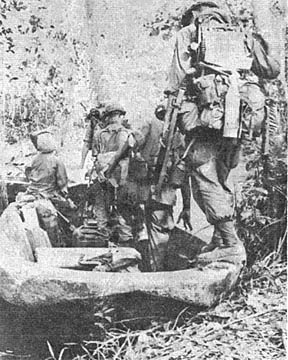 |
Page 2 TROPIC LIGHTNING NEWS June 5, 1967
Decorated
| SILVER STAR | |
|
1LT Harry R. Stewart, Co. C, 2nd Bn., 27th Inf. SP4 Richard L. Hadd, Co. A, 2nd Bn., 27th Inf. |
SP4 Darrell Taylor, Co. A, 4th Bn., 9th Inf. PFC Miguer Rivera DeJesus, Co. A, 2nd Bn., 27th Inf. |
| BRONZE STAR (VALOR) |
|
|
PSG John R. Sheetz Jr., HHC, 1st Bn. (Mech), 5th Inf. SP5 Raymond L. Bapst Jr., HHC, 1st Bn. (Mech), 5th Inf. SP4 Francis Condon, Co. A, 1st Bn. (Mech), 5th Inf. SP4 James A. Thomas, Co. A, 4th Bn., 9th Inf. |
PFC Kenneth Kralick, Trip. B, 3rd Sgdn., 4th Cav. PFC James H. West, Co. C, 1st Bn. (Mech), 5th Inf. PFC Charles G. Wright, Co. B, 4th Bn., 9th Inf. |
| ARMY COMMENDATION MEDAL (VALOR) |
|
|
SSG Dale K. Finnemore, Co. A, 4th Bn., 9th Inf. |
SP4 James W. Pyle, Trp. D, 3rd Sqdn., 4th Cav. |
| BRONZE STAR |
|
|
LTC Charles A. Gillis, HHC, 2nd Bn., 14th Inf. |
SFC Tadashi Yamamoto, 25th Admin. Co. |
| PURPLE HEART |
|
|
1LT Jesse O. Pearce Jr., Co. A, 6th Bn., 9th Inf. 1LT Claude Phipps, Co. A, 1st Bn. (Mech), 5th Inf. SMC Carl D. Craner, HHC Btry., 3rd Bn., 13th Arty. SFC Walter E. Jackson, HHC, 4th Bn. (Mech), 23rd Inf. SSG Herschell L. Antee, HHC Btry., 3rd Bn., 13th Arty. SSG Jimmie Robinson Jr., Trp. B, 3rd Sqdn., 4th Cav. SGT Ronald N. Dedenbach, Co. B, 1st Bn. (Mech), 5th Inf. SGT Lee J. Doran, Co. A, 4th Bn. (Mech), 23rd Inf. SGT William A. Rush, Trp. B, 3rd Sqdn., 4th Cav. SGT Raymond L. Starkey, Co. B, 1st Bn. (Mech), 5th Inf. SGT Lee D. Williams, Co. C, 4th Bn. (Mech), 23rd Inf. SGT Leroy Young Jr., Co. C, 4th Bn. (Mech), 23rd Inf. |
SP4 Edward H. Beaver, HHC, 2nd Bde., 25th Inf. Div. SP4 John R. Booth, HHC, 2nd Bde., 25th Inf. Div. SP4 Richard Ellsworth, Trp. A, 3rd Sqdn., 4th Cav. SP4 Ralph E. Smith, Trp. B, 3rd Sqdn., 4th Cav. PFC Jerry W. Byers, Co. C, 4th Bn., 9th Inf. PFC Brian N. Jacobson, Co. C, 1st Bn., 27th Inf. PFC Leroy B. Johnson, Co. B, 2nd Bn., 14th Inf. PFC Larry D. Miller, Co. C, 4th Bn., 9th Inf. PFC Ronald G. Mugrage, Trp. B, 3rd Sqdn., 4th Cav. PFC John R. Racz, Co. C, 1st Bn., 27th Inf. PFC Mikel D. Rhodes, Trp. A, 3rd Sqdn., 4th Cav. PFC Edward J. Swift Jr., Trp. B, 3rd Sqdn., 4th Cav. |
Editorial
Its a Two Way Street
It is a two way street. Criticism is a give and take situation.
When someone criticizes you in a caustic, non-constructive manner, you
probably won't pay much attention to the criticism. The words spoken are just
words and the only effect they have is to move your frame of mind to dislike of
the person.
When someone criticizes you in a constructive manner by pointing out what
exactly it was that you did wrong, and attempts to give you advice as to how you
can correct what was done wrong or prevent it from happening again, the chances
of you listening and following the advice are much higher.
No one likes a person who yells and shouts when someone does something
wrong. That isn't the right way to get things accomplished, it is also a way to
lose any respect the man might have had for you to start with.
Taking advice or criticism works the same way. Keep an open mind and look
for positive suggestions how you can improve your work or prevent further
"goofs."
When you are giving or taking criticism keep these points in mind. Give it
constructively and accept it positively. Remember when you give criticism that
you make mistakes too and you're not perfect. Don't criticize a person with the
attitude that you are perfect.
Harmony in relations creates better working conditions, higher work output
and better quality work.
Hol Chanh Increasing
SAIGON - A total of 2805 Viet Cong and North Vietnamese of various categories
turned themselves in to the South Vietnamese government during April under the
Chieu Hoi Program.
This figure brought the 1967 total to 13,551 since Jan. 1. The number for
the first four months of this year represents 66.9 per cent of the returnees for
the entire year of 1966.
If present trends continue, as many as 40,000 may accept the offer of food,
clothing, rewards for returned weapons, and a chance for a new start in life
during 1967.
Since the program started in 1963, the South Vietnamese government has
welcomed 61,582 Viet Cong and North Vietnamese back through the program.
Returnees are offered a choice after orientations at one of several Chieu Hoi
centers. They may learn a trade, join a South Vietnamese military organization,
work with Free World forces, or take part in programs designed to enable other
VC and NVA personnel to take advantage of the program.
June 15 Start For Army Photography Contest
The 12th All-Army Photography Contest is under way and you are in one of the
best areas of the world to obtain prize winning pictures.
The competition is divided into two basic areas with subject breakdowns after
that. The two areas are Black and White Photographs and Color Transparencies.
The black and white must be printed on paper of least 80 square inches and no
larger than 480 square inches. Photographs may be drymounted, provided mounts
are cropped to edge of the photograph so there is no border. Photographs may
not be tinted.
Color Transparencies may be up to 4 by 5 inches maximum in size and must be
submitted in some type of protective covering such as plastic-type envelopes.
Glass mounts will not be accepted.
The breakdown as to subject matter ranges from People to Action. Others are
Babies and Children, Animals and Pets, Scenic, Military Life, and Experimental.
Photos must fall under one of these categories.
The pictures will be judged under nine different criteria. One of the most
important of the criteria is impact. This deals with what the viewers reaction
is to the photograph the first time he sees it.
Freshness of approach is the second judging criteria. Story telling and
technical skill used are two more criteria.
Under the heading, quality, falls three sub-headings. Sharpness of the
important subject matter is desired unless a deliberate lack of sharpness is
used for a special effect.
Graininess of the photograph falls also under use of it or not for special
effects.
Under contrast the judges attempt to determine if the photographer used
contrast with discrimination.
Photographs for the contest will be accepted from June 15 to July 15. Send
entries for the Photography Contest to: HQ, USARV, Attn. Special Services
Office, APO 96307.
Recruiting Duty Open in States
AFN - The U.S. Army Recruiting Command is seeking enlisted personnel in grade
E-5 or higher for recruiting duty.
Openings exist for both men and women in grades E-5 through E-7 in most areas
of the continental United States, Alaska, Hawaii, and Puerto Rico.
Details on prerequisites and qualifications for recruiting duty are in
Section III of AR 601-275. Anyone interested should contact his units adjutant
or career counselor.
Applicants must have these basic qualifications: grade E-5 or higher, at
least six years service for men and three years for women, General Technical
Aptitude Area test score of 110 or higher, high school graduate or General
Education Development Test equivalent, and hold a valid civilian or Army
driver's license.
For the best chance of being accepted, personnel on overseas assignment are
urged to submit their requests on DA Form 1049 at least six months prior to
return to the continental United States.
Allotments Cut Only by Mistake
Many complaints reaching the Pentagon from servicemen's dependents say their
allotment checks have stopped for no reason.
Finance authorities say they have found the two main causes. The Class Q
allotment is cut off when a serviceman in grade E-4 completes four years service
or is promoted to a higher grade.
In both cases, a new allotment that is proper for the soldier's grade is
supposed to be started -but often isn't.
The TROPIC LIGHTNING NEWS is an authorized publication of the 25th Infantry Division. It is published weekly for all division units in the Republic of Vietnam by the Information Office, 25th Infantry Division, APO San Francisco 96225. Army News Features, Army Photo Features, Armed Forces Press Service and Armed Forces News Bureau material are used. Views and opinions expressed are not necessarily those of the Department of the Army. Printed in Tokyo, Japan, by Pacific Stars and Stripes.
MG John C. F. Tillson III . . . . . . . . Commanding General
MAJ Bernard S. Rhees . . . . . . . . . . Information Officer
CPT John P. Fortner . . . . . . . . . . . . Officer-in-Charge
SSG David G. Wilkinson . . . . . . . . NCOIC
SP4 Terry S. Richard . . . . . . . . . . . Editor
SP5 John Dittmann . . . . .. . . . . . . . Editorial Assistant
Page 3 TROPIC LIGHTNING NEWS June 5, 1967
Dog Training Now at 25th
| THEY WENT THATAWAY - PFC Morris Summers trains his scout dog in scanning an area as part of the new training program at the Cu Chi base camp. (Photo by PFC Bruce Dapprish) |
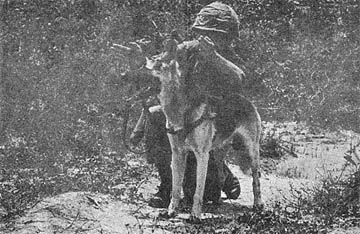 |
The small American patrol led by a scout dog and his handler pushed
through the wildly overgrown jungle of War Zone "C." The dog alerted the
handler just short of the Viet Cong ambush position. A fire fight broke out and
six of the Viet Cong were killed; only one of the Americans had been wounded.
The same story has been repeated time and time again since the 38th Scout Dog
Pit. arrived in Vietnam in July of 1965. The small unit is attached to the 2nd
Bde. of the 25th Inf. Div.
The scout dog concept has proven so valuable that the demand for new dogs and
handlers soon outstripped the supply.
Previously trained at Fort Benning, Ga., the unit now receives replacements
from its own special school conducted at the division's Cu Chi base camp.
The intensive training has not changed. The same maneuvers and rough
obstacle courses are used. The big difference in the new course is that 12
weeks of training is now packed into six. It's become tougher because there is
less time to do more.
All the men in the new school are volunteers. All have requested to work
with the dogs. Some of the men were in the infantry before they came to the
school, but not all. "I was a clerk before but liked to be outdoors. There's
nothing I'd rather be doing than working with my dog," explained PFC Morris
Summers of Fairmont, W. Va.
Working with the dogs first of all means meeting them. SGT Donald Purvis, an
instructor for both dogs and handlers remarked, "the first thing we do is to
take the new man to the kennels and have him talk to his dog until he knows the
dog won't bite him."
The dog then becomes the possession of his master. But most of the time it
also works the other way around.
"I really enjoy working with my dog," said new handler PFC Michael Dziekan of
Milwaukee, Wis., "he is a real friend that I can always talk to."
Most of the dogs themselves come from Lackland Air Force Base. They are then
purchased by the Army and sent to training sites. The majority of them are
German Shepherds but some are not, even though they maintain the characteristics
of the breed.
During the six week course, the dogs are trained to act as a silent warning
system. They are run through course after course designed to increase their
alertness with all their senses. Realistic training sharpens their sight,
hearing and sense of smell to detect the enemy in the thickest jungle.
But the handlers too must be trained. A typical mistake the new man makes is
to focus all his attention in the direction the dog first alerts.
If there is a second threat in the area, the dog will also alert on it, but
the handler, busy looking ahead, will miss the second signal. By the end of the
course the problem no longer exists. Both man and dog become continuously
alert.
The trainers, themselves former handlers, stress that the most important
thing is mutual confidence between dog and man. "For effective teamwork, there
must be confidence. The man must have it in his dog, and the dog in his
master," said SGT Clifton Cabaness of Baton Rouge, La.
Six weeks of tough, intensive training produce a dog-handler team that is
equal to the best. It produces a strong bond of friendship between the man and
his dog. But most important, it produces eyes and ears for 25th Inf. Div. units
that will save American lives.
| 'Lightning Two-Five' What are you doing on Monday morning between 11:45 and 12 noon? If your portable radio is tuned to Armed Forces Radio your listening to the 25th Inf. Div.'s new program called "Lightning Two-Five." Music of featured recording artists, a talk with the men in the division and a report of the past weeks happenings on Lightning Two-Five News with SSG Ray Hayes. Make it a habit every week to join SP4 Mike Halloran and Ray Hayes - The 25th Inf. Div. answer to Huntley & Brinkley in a far out way. |
Englishman in Vietnam Serves with 'Three-duece'
DAU TIENG - What does a foreign national feel about fighting in Vietnam under
US Army command?
Sitting at the HHC, 2nd Bn. (Mech), 22nd Inf., EM club at the completion of
Operation "Manhattan," SP4 Hugh Hamilton Brown, formally of Luton, Bedfordshire,
England, gave his views.
He had come to Los Angles after three years of college in England, to pursue
a career in civil engineering. He had registered for the draft after six months
residency. When drafted, and again when ordered to Vietnam, Brown had the
option to refuse and go back to his homeland.
Forever England
"I'd rather not be in the Army. Who would? But I am proud to serve here. I
feel that I'm fighting in the forefront of the battle for freedom, something
that my countryman should also be participating in. Every American that could
be here, should be; and that applies to every nation in the free world."
And what of his chances of not coming back? "It sounds a little trite, but
my feelings were expressed by an English poet a few hundred years ago," said
Brown. "If I die in some corner of a foreign field, it will be forever
England."
Army Now Younger
Members of the Armed Forces are younger and more educated, according to
manpower statistics released in April.
The drop in the average age of military men to 23.2 years as of last June was
attributed to first-term enlisted men and officers who make up about half the
total active force. Most volunteers enlist in their teens, while officers
usually enter active duty around 20.
Higher educational attainment in both officer and enlisted ranks was
attributed to selective recruiting and technological changes in the American
society. Only 55.5 per cent of all officers were college graduates and only 55.2 per
cent of all enlisted men had high school diplomas in May 1965.
Artillerymen Re-do School
DAU TIENG - Silence prevailed in the Dau Tieng Nursery School, as the
children watched their teacher finish writing on the blackboard. "Now repeat
after me," he told them, and thirty-two voices echoed throughout the recently
completed building.
Earlier the nursery had been a dull, aging, structure. Now it shines with a
new coat of paint, while chairs and tables enliven its interior. The completion
of the nursery was brought about through a Civic Action project of the 2nd Bn.,
77th Arty.
This is a Typical 'Tomahawk' Day
By PFC Joe Plott
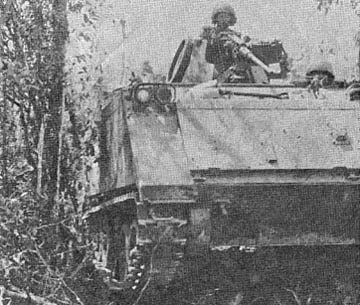 Out of the dark low overcast I sky the sun gives a bright glance breaking the
news that another day and another sweep for the men of the 4th Bn., 23rd Inf. (Mech),
25th Inf. Div. The typical "Tomahawk" is way ahead of his morning "alarm
clock." He has been up for an hour or more now.
Out of the dark low overcast I sky the sun gives a bright glance breaking the
news that another day and another sweep for the men of the 4th Bn., 23rd Inf. (Mech),
25th Inf. Div. The typical "Tomahawk" is way ahead of his morning "alarm
clock." He has been up for an hour or more now.
Already the red ants are running around in their usual annoying manner,
occasionally a spider falls out of a tree and finds its target. A quick blow
sends him on his way.
He can tell it's going to be hot today, just as it has been day in and day
out. His helmet is tucked neatly on his head, his girl's picture covers a
portion of his steel pot.
The command is given to load on the tracks. As he sits in the track he
studies the faces of the other four men. They are a team. Each of them knowing
what the other's reaction will be in many different situations.
They have lived together, waded through mud, slept in rain, gone on patrols,
divided their hot beer and argued about who was going to have the ham and eggs
"C" rations; all of this for six months. They are unbeatable.
As the tracks plow through the rice paddies, many daydreams are generated,
savored and discarded. The infantryman. A quick stop for a contested "C"
ration lunch and he is back on the move.
The sun seems to set differently for the infantryman in a wartorn country.
The setting is not a sign of peace and rest but a reminder that danger could
linger only meters away. Danger that will have to be watched and listened for
throughout the night.
Then the most cherished words of the day are heard as the famed call "Hey,
the mail is here," rings out.
He gets his letter and reads of life back home and falls into a semisleep.
He sleeps light and at the same time listens. It has been another day for the
"Tomahawk."
Circuit Rider
IG Riding the Range
Back in the days when the Wild West was woolly, it was considered quite an
improvement when Judge Roy Bean established the Law west of the Pecos.
Drawing on his Texan heritage, LTC Arthur W. Knoll of El Paso, has decided to
apply something similar to his job as Inspector General (IG) of the 25th Inf.
Div.
Knoll' intends to become a "Circuit Rider" bringing IG services to the troops
of the division in the field. "I hope to increase combat effectiveness by
solving the troops' problems out in the field, right where they originate," says
the colonel. "It should cut down considerably on lost man-hours for the combat
elements and significantly reduce the administrative overhead."
This IG-mobile concept, Knoll feels, should allow his section to better meet
the mission of the Inspector General and make them much more accessible to the
men.
He also hopes to better gain the confidence of the "Tropic Lightning"
soldiers and commanders, showing them just how easily most of their
administrative and personal difficulties can be resolved.
Knoll has just recently assumed his duties in the division, after attending
the Inspector General's School in Saigon.
Page 4-5 TROPIC LIGHTNING NEWS June 5, 1967
'Golden Dragons - Sweep and Seal
Photos by SP4 Larry Craig and PFC Bill Wermine
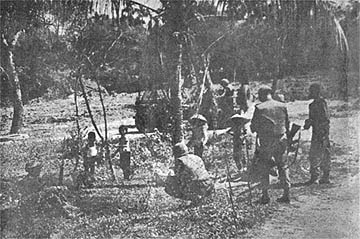 |
FRIENDS ANYTIME - Vietnamese children offer diversion from the routine of a search and destroy mission near a Vietnamese village. The "Golden Dragon" troops had already searched the village. |
| EXTRA PROTECTION - A gun jeep guards the woodline as the men of the 2nd Bn., 14th Inf., are searching the village of Phu Hoa Dong. VC snipers had been active but stopped when the gun jeep pulled up. |
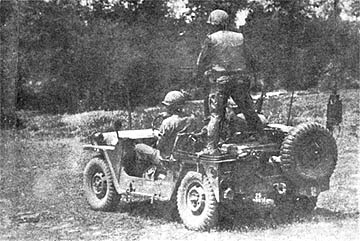 |
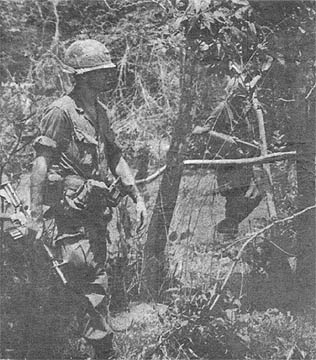 |
SLOW BUT SURE - Men of Co. B, 2nd Bn., 14th Inf., recon a heavily booby trapped area near an abandoned VC village. |
| KEEP YOUR DISTANCE - In the vicinity of Phu Hoc Dong near the Saigon River, the men sweep across a field along a tree line. |
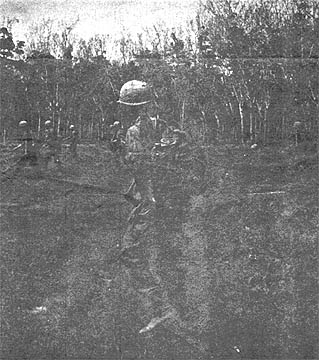 |
Page 6 TROPIC LIGHTNING NEWS June 5, 1967
Arty. Men Try Inf. Job
"It was fun while it lasted but I believe in the future I'll stay in my motor
pool and leave field operations to the Infantry, commented SGT Kendrick Boardman
of Billings, Mont., on a mission that started out as a tunnel destroying
operation and ended with him and four other 25th Inf. Div. soldiers chasing a
Viet Cong across the fields and finally capturing a Chinese claymore mine.
The incident took place at one of the division's forward fire support bases
at Soui Cao, 32 kms northwest of Cu Chi, during Operation "Manhattan."
Boardman, SP4 Milford Noble of Wahoo, Neb., PFC Myron Letcher of Emery, S.D.,
all members of the 3rd Bn., 13th Arty., and SSG Gerald Davenport of Kalamazoo,
Mich., and SP4 Richard Dupin of Decatur, Ill., both of the 5th Bn., 32nd Arty.,
had been going out into the area near their perimeter for several days prior to
the incident looking for aiming stakes and other signs of VC activity. The 13th
Arty. had had several claymore attacks and received other fire from that general
area.
Fleeing VC
"That morning however," continued Boardman, "we found a freshly dug tunnel
and decided to go back and get some dynamite and blow up some of the tunnels we
had found previously. We blew the tunnel near the perimeter and went over to
another that we knew came out in a hut in a partially destroyed village about
300 meters from the perimeter and blew that one.
"While we were on our way to a third tunnel Davenport and I spotted a
Vietnamese man standing at the edge of the woods across the field. We all
ducked down below the dike to see what he was going to do and then noticed that
he was carrying something green. We decided to check his ID card ... he saw us
and started to run. Dupin hollered at him to stop and when he didn't, fired a
round at him.
"We left Letcher to guard the dynamite and also as a rear guard in case there
were any more VC in the area and he went into one of the huts where he would
have some cover. Davenport circled around to the left, Dupin went straight
ahead and Noble and I circled around to the right. We heard shots off to our
left but Noble and I were in a patch of woods and couldn't see anything. Dupin
meanwhile had come upon a Chinese claymore mine sitting beside a well with some
wires leading down into the well.
Punji Pit
"Noble and I were trying to figure out the best way to get through the woods
when Noble saw two paths, one was narrow and pretty well blocked up with
branches but the other was clear and wide enough for two men to walk abreast.
He started to move down the path but the ground in front of him didn't look
quite right so he called me over. We started feeling around with a stick and
uncovered a freshly dug punji pit about three feet wide, four feet long and
two-and-a-half feet deep. It was so fresh the bamboo stakes were still green.
"Davenport had lost contact with the VC but claimed he had wounded him so we
joined Dupin at the well and I sent Noble back to keep Letcher company. After
determining the claymore wasn't wired up to fire we approached it and pulled the
large green coil of wire out of the well. We then took the wire and mine,
picked up Letcher and Noble and went back to the battery area and reported to
CPT William E. Noran, the Headquarters and Service Battery commander."
After receiving Boardman's report, Nolan of Niagara Falls, N.Y., led a patrol
that included SGM Carl D. Craner of Worcester, Mass., the 13th Arty. sergeant
major, back into the area. While searching the partially destroyed village they
found a hut with fresh blood on the floor, substantiating Davenport's claim of
having wounded the VC he was chasing. Two carbines with 130 rounds of
ammunition and several papers were found, but no more VC.
`Warriors' Become Colorful Unit
DAU TIENG - The 2nd Bn., 12th Inf., "Warriors" now situated in Tay Ninh and
outlying fire support bases have a new way of distinguishing themselves.
As an added incentive towards achieving pride in their unit, each man has the
head of an Indian warrior painted on the side of his camouflage cover and the
butt of his weapon. A different color distinguishes one company from another as
HHC displays black, Co. A, red, Co. B, green, and Co. C, blue.
Just recently an effort was made by the companies to get the headgear of all
their men painted, especially those who have been in the unit only a brief
time. Besides instilling pride in the unit, the Indian head also serves as a
means of marking headgear and weapons so they can be easily identified.
Wolfhounds in NY Parade As Many March Pro-VN
"We stayed up all night and had nothing to do so we wrote a letter to Mr.
Gimler," said PFC Douglas Adams of Monticello, Iowa.
Three members of the 1st Bn., 27th Inf. "Wolfhounds," wrote a letter to Ray
Gimler of Rockway, N.Y. They had discovered an article in the New York Daily
News stating that Mr. Gimler was chairman of a pro-Vietnam parade in New York
City.
Gimler took the letter and reprinted it along with the address of the men in
a full page advertisement for the parade in the New York Daily News.
The three men are Adams, PFC John Casey of Bronx, N.Y., and SP4 Wayne Force
of Cranford, N.J. In the letter they asked if there was some way the
"Wolfhounds" could be represented in the massive parade.
They were represented, and in a big way. "From all the letters we've been
receiving there must have been a lot of people marching for us," said Force.
"One lady wrote that the parade was led by 25th Inf. Div. posters." The men
received two of the posters in the mail and said that at least 18 others were
carried.
Soon after the parade was over Mrs. Loli de Puglia of Manhattan telegrammed
the men to say that her poster was on the way to the 2nd Bde. soldiers. "Sure
enough," said Force, "in a few days we received it, cut up in four pieces to fit
the envelope. All we had to do was tape it together."
That was only the beginning. Letters have been arriving ever since along
with another poster. "We've received more than 50 letters and don't have the
time to answer them all so we're circulating them among our platoon so that
everyone will get a reply," said Adams.
The letters have come from all over the states of New York and New Jersey and
congratulated the battalion for its work. "Everyone has been writing," said
Casey, "from retired colonels to airline stewardesses. It's been great."
Cu Chi Head Nurse Speech Pathologist
By SP4 Rick Calvo
Head nurse during the day, speech and hearing pathologist during off duty
hours . . . CPT Ellen Langston of Laconia, N.H., finds her tour in Vietnam busy,
but rewarding.
Ellen arrived in Vietnam last September from Walter Reed Army Medical Center.
Since that time she has been working full time as a nurse with the 12th Evac.
Hosp. at Cu Chi.
Holding a bachelor of science degree in Nursing, a masters in Education, and
a certificate of advanced study from Boston University, she is presently the
head nurse of the hospital's Vietnamese patients ward.
The captain, who is also a registered speech and hearing pathologist, sets
aside from six to 12 off-duty hours weekly to work with men from units all over
Vietnam who come to receive aid for stuttering and articulation problems.
"I often receive calls from company commanders asking me to help some of
their men. `I have a man here' they say, and I can't understand what he says .
. . Can you help me? And thats how most of the men are referred to me for
treatment," explains the captain.
But speech pathology is a slow process requiring many hours of informal
conversation. "Stuttering," the captain explained, "is really never cured. All
that can actually be done is to teach the client to stutter better. By this I
mean, eliminating the crutches most stutterers use, and changing the pattern of
the stutter."
Articulation problems, which concern difficulties in pronouncing words
correctly, are other problems she helps soldiers to conquer.
"In one case," nurse Langston recalled, "a young college grad came to me with
a pronunciation problem. It detracted a great deal from his personality. As I
remember, he couldn't pronounce the word "straight," but after many hours of
working with him, the man rotated home happily saying `straight.' I was so glad
I could help him."
Ellen Langston, listed as a medical nurse in the hospital's table of
organization (TO&E), says she derives great pleasure in providing the men in
Vietnam with a specialize service.
Ivymen Uncover VC Mine Factory
DAU TIENG - Operating through dense jungle northwest of their base camp at
Dau Tieng, Co. C, 2nd Bn. (Mech), 22nd Inf., has recently found and destroyed a
VC boobytrap and mine factory, complete with a number of machines and completed
mines.
Included in the find were 20 homemade 12 gauge shotguns, two pistols, three
rifle barrels, 55 rifle grenades, 30 assorted types of hand grenades, one VC
type Claymore mine, molds and castings for fuses, and three CHIC0M RPG-2
anti-tank rounds.
1LT Rodger W. Frydrychowski of Chicago, who recently took command of the "Ivymen,"
ordered the base camp and another camp containing a mess hall and five hooches
destroyed.
| NEW COMMAND - MG Fred C. Weyand assumes command of 11 Field Force Vietnam and is awarded the Distinguished Service Medal. GEN William C. Westmoreland presented the award to the former CG of the 25th Inf. Div. |
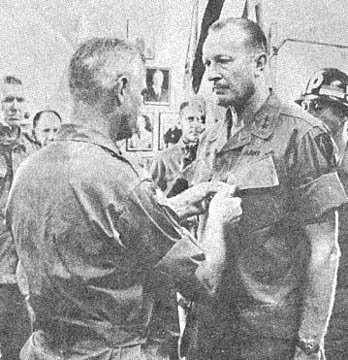 |
Page 7 TROPIC LIGHTNING NEWS June 5, 1967
Fight Shatters Quiet
When many of the soldiers in the Cu Chi base camp of the 25th Inf.
Div. were knocking off for chow, the fifteen man ambush patrol was just wending
its way out through the final protective wire. Ahead lay a dark 3000 meter
march through Viet Cong territory to the designated ambush site.
The patrol from Co. C, 1st Bn., 27th Inf., reached their position a
little after nine p.m. and went silently to work setting up Claymore mines and
weapons firing positions. The ambush, an L-type, lay across a trail with a
large rice paddy to one side.
Five hours of waiting came and went. The men were alerted
occasionally by the sound of insects croaking or a small animal breaking a
branch. But when they looked, there was nothing.
"A terrible scream came from the right just after two o'clock,"
said SGT Melvin Screws of Natchez, Miss., a member of the patrol. "Then
someone was yelling orders in Vietnamese and a hail of grenades came bouncing
into the position." The multiple blast wounded two of the soldiers and a
violent firefight broke out. Grenades and small arms rounds flew back and
forth.
"We could see many of them and I'm sure we got a lot, but the fire
was so tremendous that they drove us out of the ambush position into the rice
paddy," said SP4 Ernest Frost of Newburgh, N.Y.
Driving the men away from the ambush site proved to be a big
mistake. The soldiers drew back under the heavy fire and called in
artillery that blasted their former firing positions.
"The artillery really broke them up," said Frost, "and that was the
last we saw of them."
As the sun came up, a search of the area showed that the Viet Cong
had severed the firing wires of the patrol's claymore mines, turned them around,
and wired in their own detonators. Luckily the VC hadn't used them.
"We only found one Viet Cong body, but there were blood trails all
over the place and a bloody stretcher that they had used to haul off their
dead," said Screws. The searchers also found two Chinese claymores, 40
grenades, and an AK-47 automatic weapon next to the dead VC.
The patrol wearily came back in through the protective wire just as
many soldiers on the base camp were heading for breakfast.
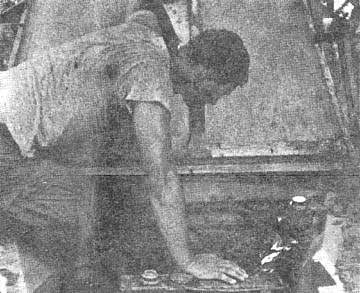 |
WHAT HAVE WE HERE? - SP4 Dannel E. Kochh of 2nd Bn., 22nd Inf., inspects a captured VC truck. (Photo by PFC James Friar) |
Mech Gets New CO
LTC Chandler Goodnow of Keene, N.H., recently assumed command of
the 1st Bn. (Mech), 5th Inf., during a brief ceremony at the battalion's combat
base camp.
Goodnow takes command from LTC Richard Rogers who is hospitalized
at Cu Chi after his tracked command vehicle hit a Viet Cong mine during
Operation "Kolekole."
COL Marvin D. Fuller, commander of the 2nd Bde. accepted the
battalion's colors from Executive Officer MAJ William I. Harris and presented
them to the new "Bobcat" commander. "With this ceremony you take command
of a proud unit," said Fuller as he offered his congratulations.
Goodnow comes to the 2nd Bde. after tours with USCONARC
Headquarters, the 52nd Inf. Bn., the 2nd Bn., 19th Inf., and the 38th Inf. Regt.
`Golden Dragons' Take on VC at OP
There was a gloomy overcast promising heavy rain for the late
evening hours, as SP4 Elias Morgan from Marietta, Ga., and his detail moved out
to man one of the outposts set up every evening to provide early warning
security for the fire support base located in the heart of the Boi Loi woods in
Tay Ninh province.
As a member of the 2nd Bn., 14th Inf. "Golden Dragons," 25th Inf.
Div., he had been on many of these patrols before. He knew the discomforts
of these lonely night security watches, the persistent mosquitoes, and other
insects not to mention eerie sounds emitted from the surrounding jungle.
As the day turned to night, Morgan and three other men moved
silently in the rain toward their outpost (OP). As they set up their OP
along a woodline they noted that they were in a good position to spot snipers or
infiltrators moving toward the perimeter. Since this area was thickly
infested with VC, the possibility of making contact was great.
At about two a.m. the rain had subsided and Morgan had assumed his
guard, everything seemed normal. The crickets were chirping out their
steady monotonous drone. Occasionally a Macaw would call out with its
distinctive cry not quite unlike the caw of a crow.
The men were used to these sounds. They were comforting in a
way. But they mean even more than comfort. Whenever there is a break
in the pattern of these sounds it means that there is something moving around,
more than likely an animal predator but sometimes a human.
Suddenly, a few minutes after assuming his 2 o'clock guard, the
jungle became silent. Morgan tensed. His hand instinctively went to
the trigger of his M16. Without making a sound he alerted his comrades by
touching them.
Almost instantaneously, a dark form appeared, silhouetted against
the woodline. It was moving rapidly toward their position. Morgan
watched until he determined the form as being unfriendly.
Slowly he raised his weapon to his shoulder and switched the weapon
to full automatic. He took careful aim and calmly blasted the hostile form
with a burst of deadly automatic fire.
Later the next morning, Morgan stated, "I thought that I had
missed, but upon investigating I found a dead VC 150 meters from the OP."
It was the opinion of the men that the heavily armed VC was trying
to sneak up and wipe out the OP and then move out to harass the perimeter.
He was carrying several documents, one of them saying that he was
VC soldier of the year in 1965. Apparently he was out to recapture his
title for 1967. Unfortunately, this year one "Charlie" will miss spring
training. The VC soldier was well armed with nine Chinese Communist
grenades and several clips of Russian ammunition.
2-22 Finds 3 VC Trucks
DAU TIENG - Three trucks used by the Viet Cong to haul supplies
through the jungle of War Zone "C" were found recently by the 2nd Bn. (Mech),
22nd Inf., 3rd Bde., 4th Inf. Div., on Operation "Ahina," 10 kms north of Dau
Tieng.
One of the vehicles had been destroyed by direct hits from
airstrikes in that area several weeks ago. The other two trucks, one a
Willey van and the other a jungle-worthy Land Rover were found nearby in a
make-shift garage.
The garage had been dug to a depth of four feet and covered with
aluminum sheeting. The area was protected by mines and booby traps, all of which
were uncovered by the "Ivymen."
The captured trucks and material were extracted by CH-47 Chinook to
the Dau Tieng base camp of the 3rd Bde., for repair and use by the brigade civil
affairs program.
PFC Gerald E. Picard of Springfield, Mass., had driven the Land
Rover to the landing zone for extraction and he had other ideas for its
disposition.
"I heard we could take souvenirs," Picard said. "Now, all we
have to do is bore it out a little, channel it, a few dual carbs, a little
pinstriping - it would sure beat walking around post."
What Sort of Man Reads TLN
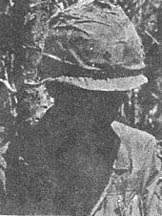 |
Like most medics he is called "Doc" by the men around him. |
Page 8 TROPIC LIGHTNING NEWS June 5, 1967
'Manhattan' Now
Wrapping Up
With the initial phase of Operation "Manhattan" over, the operation
continues now in its 43rd day.
The multi-division action combined the 25th Inf. Div., the 1st
Div., the 3rd Bde., 4th Inf. Div., and the 11th Armd. Cav. Regt.
The U.S. forces started working through the Ho Bo and Boi Loi woods
as well as fighting down the Saigon River from a starting point near the
Mechelin Plantation.
The pincer of the operation started closing with the 25th units
pushing up the river and in from the west while the Big Red One and the Ivymen
came down the river and in from the east.
The body count and possible VC killed total is not as high as many
operations, but this was more than compensated for by the amount of supplies and
fortifications found and destroyed.
Tremendous amounts of ammunition were found in fortifications and
tunnels during the operation. More than 380,000 rounds of small arm and
automatic ammunition were found. This is 19 times that found during
Operation "Junction City."
More than 1400 heavy explosive rounds were uncovered ranging from
mortars to recoilless rifle projectiles.
Some 380 mines and booby traps were blown up after being discovered
and more than 320 tunnels were destroyed.
A VC province headquarters tunnel complex was discovered, "run,"
and destroyed.
Mech LP Kills Two
Two Viet Cong were killed as they attempted to sneak past a
three-man listening post (LP) to the perimeter of the 1st Bn. (Mech), 5th Inf.,
combat base recently during Operation "Kolekole," a combat operation of the 2nd
Bde., 25th Inf. Div.
Photographs carried by the VC showed enemy training operations.
The men had waited until an estimated 15 man Viet Cong unit had
come next to their position and fired a claymore mine. "After the claymore
went off we stayed hidden and checked the area out with a night vision device,"
said PFC Paul Williams of Kingsport, Tenn. "We knew that we hadn't killed
them all.
They stayed hidden until dawn when they searched the area and found
two dead VC and several blood trails. "We checked the VC and found the pictures
and a flag," said Williams.
The photographs showed what appeared to be a basic training camp.
"One of the pictures was of a rifle range with what looked like a sergeant
watching a man fire," said SP4 Gary Ceisner of New York.
The flag had a bright green cross and a red circle and carried a
message in Vietnamese. When translated, the message impolitely suggested
that the mechanized soldiers leave the area.
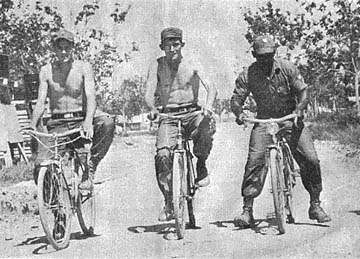 |
BICYCLE BUILT FOR HO - Members of Co. A, 1st Bn., 27th Inf., take a leisurely spin around the battalion area and soak up a little sun on "two-wheelers" captured during Operation 'Manhattan.' The VC bicycle were found along the Saigon River. (Photo by PFC Bruce Dapprich) |
35th Infantry Platoon
Chow, Called Short
DUC PHO - "This underbrush is so thick, we have to cut our way
through to move," the squad leader's voice spoke over the radio.
CPT Jacky A. Burr of Tulsa, Okla., picked up the horn. "Keep
pushing," he said.
The 3rd Plt. of Co. A, 1st Bn., 35th Inf. had just stopped for a
rest and some chow when they heard automatic weapons fire and M-79 grenade
rounds going off on a hill directly to their front. The 1st Plt. had made
contact with elements of the NVA.
Chow was called short, and Burr moved his men out to aid the
forward platoon.
They were faced with the task of moving through dense vegetation up
the finger of the mountain just to the west of the action.
A noon-day sun spread its heat over the entire area; sweat blurred
vision; thorns tore at the skin. Often the men had to crawl through the
brush to avoid becoming entangled as they moved steadily upward.
Word came over the radio that contact had been broken and
that a recon group sent out had discovered a large cache of polished rice, six
illuminating 60-mm mortar rounds and various pieces of NVA field equipment.
Burr halted his platoon while he continued to receive reports on
the findings and reports of numerous sightings of enemy positions and enemy in
the open.
Soon it was to become a job for the artillery - "an. artilleryman's
field day," as Burr phrased it.
Then the 1st Plt. radioed that they saw three NVA soldiers bathing
in a nearby stream with at least five more men in the immediate area. He
called in artillery fires. Direct hits were reported by gunships surveying
the area.
The 3rd Plt. then proceeded to an LZ to set up for the night.
Their next day's work was all cut out for them: policing up the battlefield and
bagging the twenty-six tons of polished rice they had uncovered for transport to
the Duc Pho refugee
LTC Ladd CO of 'Golden
Dragons'
The `Golden Dragons' have a new battalion commander.
LTC James Von K. Ladd of Perrysburg, Ohio, took over command from
LTC Charles A. Gilles May 18.
While fighting in Korea with the 3rd Inf. Div. Ladd won the
Distinguished Service Cross and Bronze Star.
The 1946 graduate of West Point attended the Command and General
Staff College and taught Military Science at Dartmouth College for two years.
He attended the Army Language School where he studied Thai. In 1962
he assumed the duties of Senior Advisor of Counterinsurgency with JUSMAG in
Thailand.
From 1964 to 1967 he worked as staff officer of the office of the
Assistant Chief of Staff in Washington D.C.
The former CO of the 2nd Bn., 14th Inf., left for an assignment
attending Tulane University Graduate school in New Orleans.
A Losing Battle
Hoi Chanh Tell of Hard Times, Why Return
DUC PHO - "We are fighting a losing
battle! We can't get any rest! We are short of food and our leaders
have not kept any of their promises to us! We are tired of being hunted
down like animals!"
These are but a few of the reasons given by Hoi Chanh in the Duc
Pho area escaping from Viet Cong control and rallying to the GVN.
Another important reason, and the one pointed to with pride by 1LT
Louis Beck, leader of the 245th Psyops Co. team attached to the 3rd Bde. Task
Force, 25th Inf. Div., has been the success of psychological warfare on the
Communists.
"I heard you talking from airplanes and read the leaflets you've
dropped," explained many of the returnees.
The leaflets dropped contain statements and pictures of other "Hoi
Chanh" ralliers and show them the power of Allied forces.
Among the leaflets dropped are "National Safe Conduct Passes" which
allow dissatisfied enemy soldiers to "Chieu Hoi" or safely turn themselves in to
free world units.
Communist cadremen have issued strong warnings to their men not to
be caught with any government information in their possession.
Despite this, the enemy troops have become avid readers of the
leaflets according to Hoi Chanh. Rewards are given as incentives for
information regarding the whereabouts of enemy mines and booby traps and for
turning in weapons.
For the past 15 years the Due Pho District of Quang Ngai Province
has been a free movement area for NVA and VC.
Suddenly the tide has turned and the enemy is no longer free to
roam and terrorize the villagers.
One former VC squad leader, now a returnee, stated, "I was in a
firefight this morning just before dawn and for every round I fired, twenty men
fired back at me. With odds like that I knew I never could win."
Since the 3rd Bde. closed the Duc Pho area on April 19, more than
120 Hoi Chanh have rallied. Thirty-three returned in a two day period, one
of which was an NVA political officer who stated, "I am returning to the GVN
because I can no longer lie to my people. I tell them we are winning and
we lose.
"I tell them food, clothing and medicine are coming but it never
arrives for them or me. Your men seem to have a will to win because they
have something to fight with and for."
The Psyops team has taken many such returnees and given them the
things which the Communists fail to give.
They are taken to the Chieu Hoi center in Quang Ngai. There
the government relocates them and, if necessary, educates them in a trade so
they will become useful citizens of Vietnam.
When asked how he felt about the sudden influx of returnees, Beck
replied, "For every Chieu Hoi that comes in I know our work has not been in
vain, and we are doing a good job of reaching the people. This is a never
ending job yet it is one where there is real satisfaction.
"We realize that Psyops alone cannot do the job but with the help
of combat forces and civic action teams, we will eventually achieve our goal
which is to display an interest in a free government for the people.
65th Slices Thru Boi
Loi
The last phase of Operation "Manhattan," that of clearing the heavy
tropical secondary growth of the southern Boi Loi woods, will be completed by
next week, reports a 65th Cbt. Engr. Bn. spokesman.
To date 3500 acres have been cleared by Co. C, aided by elements of
the 588th Engr. Bn. Security for the engineers and their heavy equipment
has been the responsibility of the 4th Bn., 23rd Inf.
MAJ William Borum, battalion plans and operations officer,
definitely feels that by clearing the Boi Loi area, Allied forces are denying
the communist-led guerillas the use of what was the center of terrorist
activities and a major supply point.
Hundreds of bunkers, tunnel complexes and trench lines, containing
tons of weapons, ammunition and food caches have been uncovered.
Many of the underground fortifications, according to 1LT Jack Hansman,
Co. C commander, are old but show signs of recent improvement.
Thanks to:
Gary Hartt, 2nd Bn. (Mech.), 22nd Inf.,
for sharing this issue,
Kirk Ramsey, 2nd Bn., 14th Inf. for creating this page.
This page last modified 06-17-2005
©2005 25th Infantry Division Association. All rights reserved.